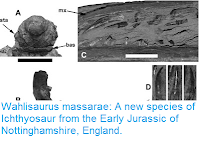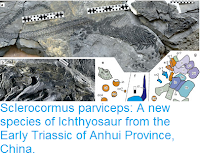An Ichthyosaur fossil has been found on a beach in Somerset, England, by a man waling his Dogs. Jon Gopsill of Stolford in Somerset was walking his Dogs, Poppy and Sam, on a beach near his home when he made the find. The specimen appears to comprise a spinal column about 1.65 m in length, plus a number of ribs, although more material may be buried at the site. Mr Gopsill has informed Somerset Heritage and the Natural History Museum of his find.
The Stalford Ichthyosaur. Jon Gopsill/BBC.
The beaches at Stalford comprise a wide foreshore platform mad up of Early Jurassic Lias limestones, noted for their production of extensive shallow marine fossils, including large Marine Reptiles. England is noted for having produced a large range of Early Jurassic
Ichthyosaur specimens, though the majority of these have come from the
Jurassic Coast area of Dorset, with specimens also described from
Somerset, Leicestershire and Warwickshire.
Ichthyosaurs were Marine Reptiles known from the Triassic to the
Cretaceous. They were fully-aquatic with a Dolphin-like form, and known
to have given birth to live young, rather than emerging from the water
to lay eggs, as is the case in Turtles and Crocodiles. However the known diversity of the
group is probably somewhat skewed by the fact that overwhelming majority
of known Ichthyosaurs come England, with the majority of the remaining
specimens coming from Europe, North America and Russia.
See also...
Follow Sciency Thoughts on Facebook.







